The Skylake Core i3 (51W) CPU Review: i3-6320, i3-6300 and i3-6100 Tested
by Ian Cutress on August 8, 2016 9:00 AM ESTOffice Performance
All of our benchmark results can also be found in our benchmark engine, Bench.
Agisoft Photoscan – 2D to 3D Image Manipulation: link
Agisoft Photoscan creates 3D models from 2D images, a process which is very computationally expensive. The algorithm is split into four distinct phases, and different phases of the model reconstruction require either fast memory, fast IPC, more cores, or even OpenCL compute devices to hand. Agisoft supplied us with a special version of the software to script the process, where we take 50 images of a stately home and convert it into a medium quality model. This benchmark typically takes around 15-20 minutes on a high end PC on the CPU alone, with GPUs reducing the time.
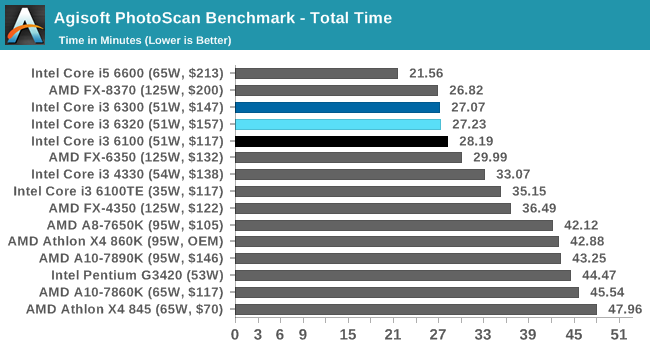
The different stages of Photoscan have different preferences for frequency and threads, but all the results are in Bench. In this case having threads matters, with the old 8-thread FX CPU barely getting ahead of the Core i3 parts. The i5 takes the lead, showing that having physical cores helps with cache management. This is further reinforced by our results staircase, which put the i3-6320 and i3-6300 at roughly equal timings but the i3-6100 almost 4% behind.
Cinebench R15
Cinebench is a benchmark based around Cinema 4D, and is fairly well known among enthusiasts for stressing the CPU for a provided workload. Results are given as a score, where higher is better.
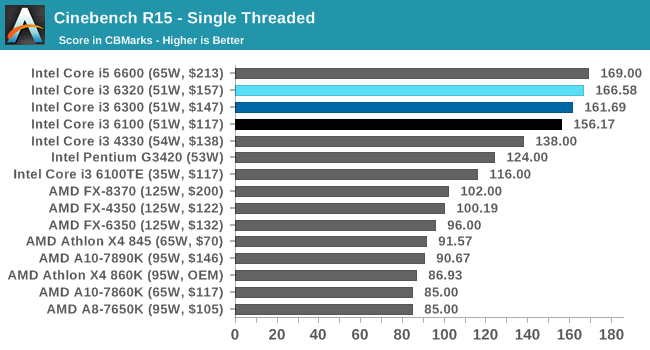
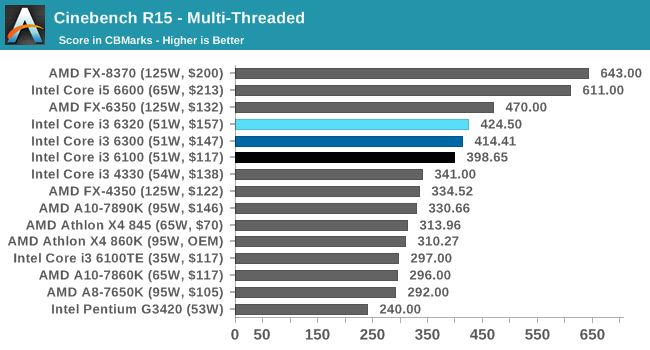
Cinebench eats threads, high IPC and high frequency for breakfast. In the single thread test, the high Intel IPC shines through, and our i3 parts sit in unison with AMD behind by up to 40%. In multithreaded land, the 6/8 thread FX processors go ahead of the i3s as expected, and our staircase slightly deviates for the i3-6100 showing that L3 cache creep is slowly coming in.
HandBrake v0.9.9: link
For HandBrake, we take two videos (a 2h20 640x266 DVD rip and a 10min double UHD 3840x4320 animation short) and convert them to x264 format in an MP4 container. Results are given in terms of the frames per second processed, and HandBrake uses as many threads as possible.
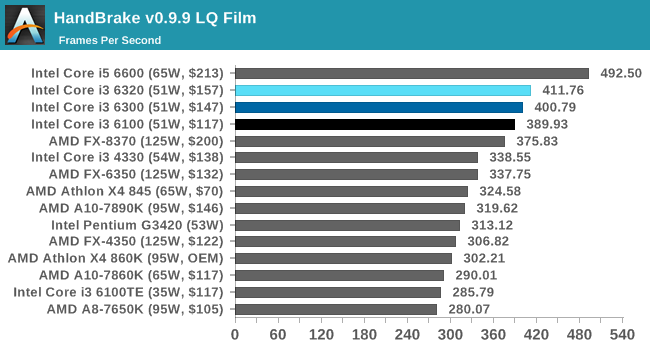
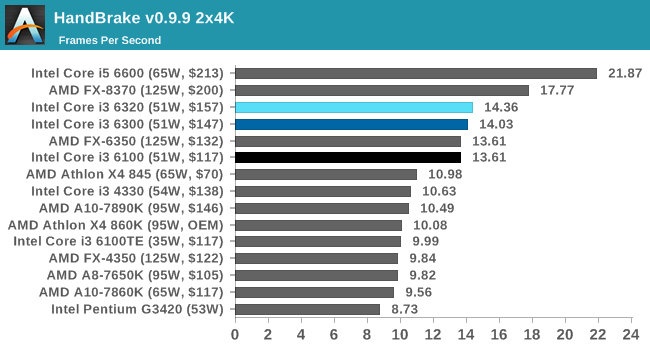
The high IPC of the Skylake parts makes a difference for the smaller frame conversion, while threads come into play for the larger resolution frames. In both cases, the regular staircase shows a lack of issues with the L3 cache differences, but it is interesting to see the X4 845 hot on the heels for the high resolution frames despite its cache arrangement. The FX-6350 sits on par with the i3-6100, showcasing the difference between a six-thread much older processor and a four thread latest process part.
Hybrid x265
Hybrid is a new benchmark, where we take a 4K 1500 frame video and convert it into an x265 format without audio. Results are given in frames per second.
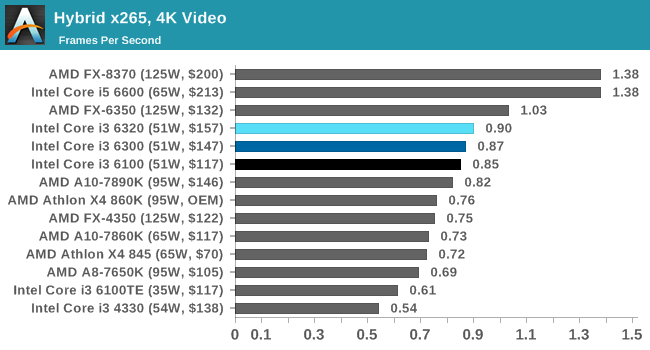
Hybrid is similar to HandBrake, and we again have a regular staircase.










94 Comments
View All Comments
junky77 - Tuesday, August 9, 2016 - link
No DX12 comparison?Meteor2 - Tuesday, August 9, 2016 - link
Another good point!BrokenCrayons - Tuesday, August 9, 2016 - link
Ian mentioned in the article that they're still using their 2015 game benchmark suite for this review. I would expect AT's 2016 benchmark list, once finalized, will include more DX12 titles. I'm not sure when those benchmarks are normally confirmed since I've never really given it much thought, but as we're wading into August, one would hope that the 2016 list will be as forward-looking as possible. However, they'll probably need to keep something from the 2015 list in order to have a comparative basis for new and old products. It's also important to retain a DX11 title or two as the older version of the API is very much alive and well at the moment.jeffry - Tuesday, August 9, 2016 - link
I think if your running an oced Sandy-Bridge (2500K) and you use your pc for gaming, its not worth the upgrade cost. Perhaps its worth to upgrade for the very high-end games with maxed out resolution and graphics features, but then id not pick an i3 (-> i7 instead).If you run simulations or any kind of HPC, you most likely have another setup anyways.
jeffry - Tuesday, August 9, 2016 - link
95% of all pp are shopping on a budget anyways, so i would spend my bucks on a new GPU instead of CPU, eg AMD Polaris or Nvidia Pascal GPU.Death666Angel - Tuesday, August 9, 2016 - link
https://www.youtube.com/watch?v=frNjT5R5XI4 You can get quite a few frames more with a modern, equally overclocked CPU. If you have the budget or get a good deal, an i7-3770k seems to be a good upgrade without having to get a completely new system with motherboard and RAM. Can be the difference between 45fps and 60fps.Voldenuit - Tuesday, August 9, 2016 - link
Thanks for the review Ian.A bit perplexed at the choice of GPUs and CPUs and game titles tested in this review.
The Core i5-2500K is a natural point of comparison since so many people are still on it. Though they are unlikely to switch to an i3 Skylake, still a useful comparison for a data point.
Those GPUs are really old. Someone building a new Skylake system would most likely be getting a 480 or 1060. Also, it would be useful to know if the i3 is bottlenecking games from reaching high framerates on 120/144 Hz monitors.
Which brings us to the choice of games. Following (in my opinion, somewhat dubious) claims by various youtube reviewers that even a skylake i5 is not sufficient for 144 Hz gaming, I'd like to know if an i3 is a bottleneck on games where framerates matter: Overwatch, DOOM, Crysis 3, Battlefield 4, etc. As well as games that stress the number of CPU cores like AOTS, TW:WH, etc.
Icehawk - Tuesday, August 9, 2016 - link
They run their benches w/o V-sync... so monitor Hz doesn't matter, you can see the maximum frame rates.I agree, some slightly newer GPUs would be good - at least a 470 or something.
leopard_jumps - Monday, August 15, 2016 - link
i3 6100 + RX 470 4GB ($200) will make $550 gaming PCleopard_jumps - Monday, August 15, 2016 - link
PCPartPicker part list: http://pcpartpicker.com/list/gfHsXHPrice breakdown by merchant: http://pcpartpicker.com/list/gfHsXH/by_merchant/
CPU: Intel Core i3-6100 3.7GHz Dual-Core Processor ($110.99 @ SuperBiiz)
Motherboard: ASRock Z170M Pro4S Micro ATX LGA1151 Motherboard ($77.98 @ Newegg)
Memory: G.Skill Ripjaws V Series 8GB (2 x 4GB) DDR4-2800 Memory ($40.98 @ Newegg)
GPU Asus Strix RX 470 4GB - $200
Storage: Western Digital Caviar Blue 1TB 3.5" 7200RPM Internal Hard Drive ($47.49 @ OutletPC)
Case: Deepcool TESSERACT SW ATX Mid Tower Case ($39.99 @ SuperBiiz)
Power Supply: EVGA 500W 80+ Bronze Certified ATX Power Supply ($43.99 @ SuperBiiz)
Total: $561.42
Prices include shipping, taxes, and discounts when available
Generated by PCPartPicker 2016-08-15 13:01 EDT-0400